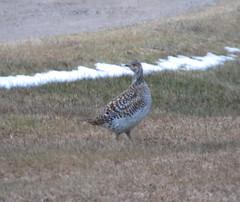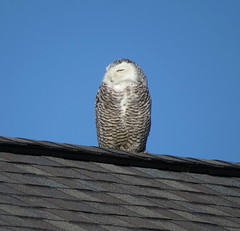Spring Valley Wildlife Area, Caesar Creek State Park
I was anxious to go birding Saturday, more so than most other days. I felt kind of guilty that I hadn’t called Jon to see if he wanted to join me, but I thought that today I needed to be alone. Just myself and my new camera. Where I could take my time and not rush. This was more of a photographic adventure than a birding adventure. Now don’t take me wrong, I wanted to see some cool birds (which I did) however I really wanted to see how my new camera operated.
The boardwalk out into the marsh at Spring Valley was pretty empty, except for a couple of photographers this cool Saturday morning. A couple of Soras were calling above the chatter of the Red-winged Black Birds as I waited to see if any Virginia Rails would call. My first of the year Yellow Warbler flitted around the bushes out in the marsh.
A small brown bird catches my attention. It’s down amongst the vegetation and cattails. I was hoping for a Marsh Wren, but I will settle for a Swamp Sparrow.
 A Drake and Hen Blue-winged Teal
A Drake and Hen Blue-winged Teal
After the boardwalk I drove over to the other section of Spring Valley. This area is in close proximity to the bike trail and hopefully some warblers. Palm, Prothonotary, and Yellow-rumped Warblers were everywhere. The morning was heating up and the activity on the bike trail was getting busy with bicycle traffic.
 A beautiful male Yellow-rumped Warbler.
A beautiful male Yellow-rumped Warbler.
 This Prothonotary Warbler was really skittish. When I first heard it sing, and was finally able to track it down, getting it’s picture was proving to be difficult. After getting a few good shots I was looking over the pictures at home. Now look on the birds leg.
This Prothonotary Warbler was really skittish. When I first heard it sing, and was finally able to track it down, getting it’s picture was proving to be difficult. After getting a few good shots I was looking over the pictures at home. Now look on the birds leg.
 I think this is either my 3rd, or 4th bird photo where the bird is banded.
I think this is either my 3rd, or 4th bird photo where the bird is banded.
After walking down the bike trail to check out a Bald Eagles nest, I made my way over to the area below the dam at Caesar Creek. In the past I’ve heard of Louisiana Waterthrush being in the area.
 Being such a beautiful day this part of the park gets especially busy with families having picnics and folks fishing. So I hiked around for a bit listening for any tell tale signs of a Louisiana Waterthrush. As with California Woods last week I struck out again. So it was time to change locations, and this time I’m going to follow the tail water from the dam downstream to Caesar Creek Gorge. I’ve found the bird here before and last year a fellow birder reported a good spot to find them. So it was back to the car for the 20 minute drive.
Being such a beautiful day this part of the park gets especially busy with families having picnics and folks fishing. So I hiked around for a bit listening for any tell tale signs of a Louisiana Waterthrush. As with California Woods last week I struck out again. So it was time to change locations, and this time I’m going to follow the tail water from the dam downstream to Caesar Creek Gorge. I’ve found the bird here before and last year a fellow birder reported a good spot to find them. So it was back to the car for the 20 minute drive.
Caesar Creek Gorge is divided into 2 sections. The trail is one big loop system, and I was heading to the upper trail. It was only a matter of a couple of minutes when I heard a rather sharp, one note call that I vaguely remember. It was close, and when I got my bins on it it became apparent what I was hearing…
 A Great-creasted Flycatcher is a wonderful bird. But what is so wonderful is how close this picture is to the bird. A picture this good alone justifies my purchase of this camera. I never would have been able to digiscope a picture this good. By the time I had everything ready the bird would have flown away.
A Great-creasted Flycatcher is a wonderful bird. But what is so wonderful is how close this picture is to the bird. A picture this good alone justifies my purchase of this camera. I never would have been able to digiscope a picture this good. By the time I had everything ready the bird would have flown away.
I made my way around the park and started my decent into the bottom land of the park that borders the river. The place I read about is a little off the trail but it was easily accessible with just a little scramble down a steep bank. The rush of the water is all I hear. A Spotted sandpiper lands on some gravel in the middle of the river. Pumps it’s tail a few times and flies up river, as does the Belted Kingfisher. Then I hear one sing. It keeps getting closer and closer. Right over head now.
 With all the excitement of finally seeing the bird I think I zoomed in too much. I cut off it’s tail in this picture.
With all the excitement of finally seeing the bird I think I zoomed in too much. I cut off it’s tail in this picture.
 When the bird is high up in the tree, and you’re below it, attempting to get a good shot is difficult. For one thing the camera is wanting to auto-focus on the closest thing. And that thing might not be the bird. I might be a branch that’s between you and the bird. So you’re looking up, trying to not lose your footing, and get a steady photo. Easy
When the bird is high up in the tree, and you’re below it, attempting to get a good shot is difficult. For one thing the camera is wanting to auto-focus on the closest thing. And that thing might not be the bird. I might be a branch that’s between you and the bird. So you’re looking up, trying to not lose your footing, and get a steady photo. Easy
After this hike I was tired and hungry and wanting to head home. However before I left I had to get a shot of these Tree Swallows .
 One thing about Tree Swallows is that they’ll sit still long enough to get it’s picture taken.
One thing about Tree Swallows is that they’ll sit still long enough to get it’s picture taken.
Notable birds for the day include: FOY-First of the Year
- Prothonotary Warbler-FOY
- Palm Warbler-FOY
- Louisiana Watertrhush-FOY
- Sora-FOY
- Red-headed Woodpecker-FOY
- Osprey-FOY
- Chimney Swift-FOY
- White-eyed Vireo-FOY
- Red-eyed Vireo-FOY
- Warbling Vireo-FOY
- House Wren-FOY
- Great-creasted Flycatcher-FOY
- Prairie Warbler-FOY
Total species for the day was 55.






















